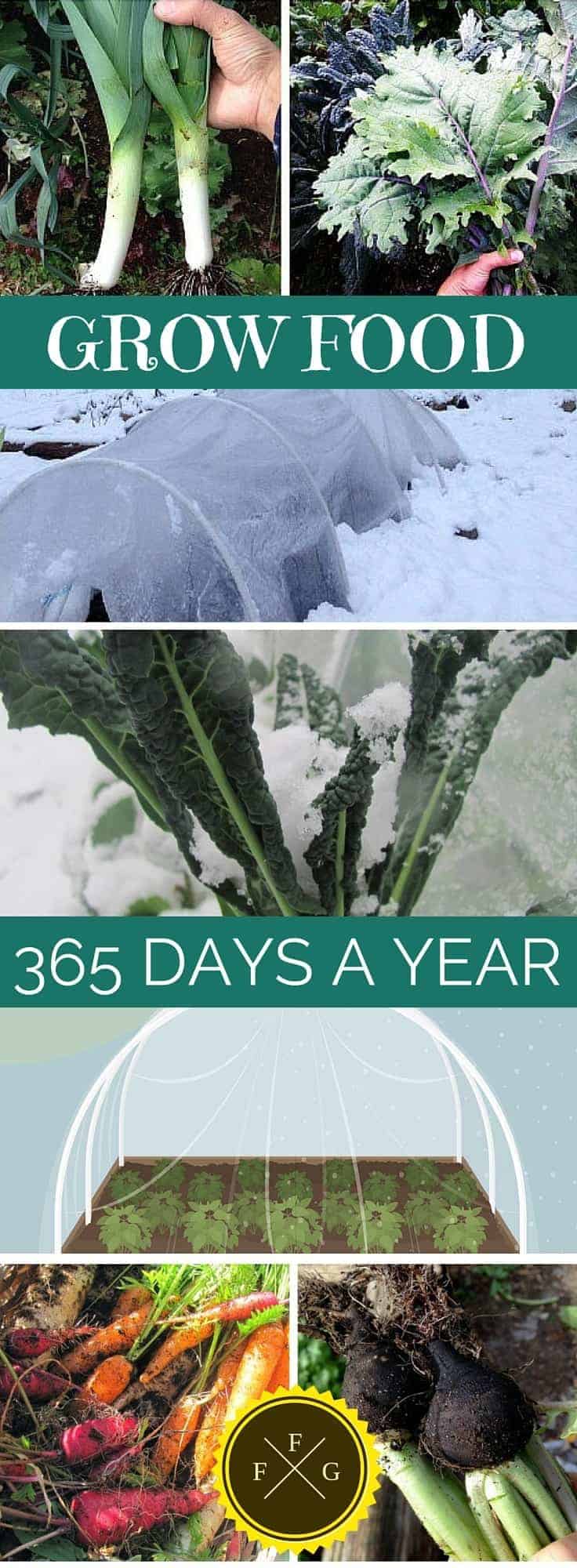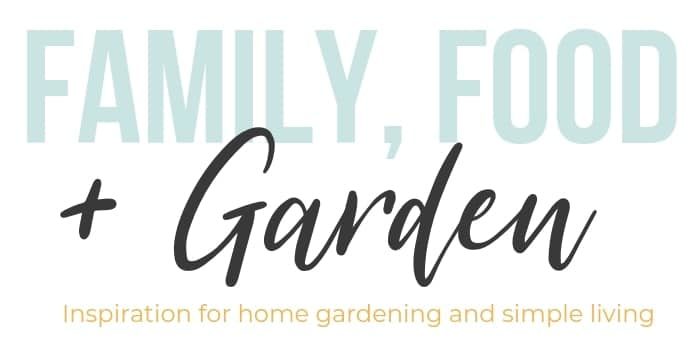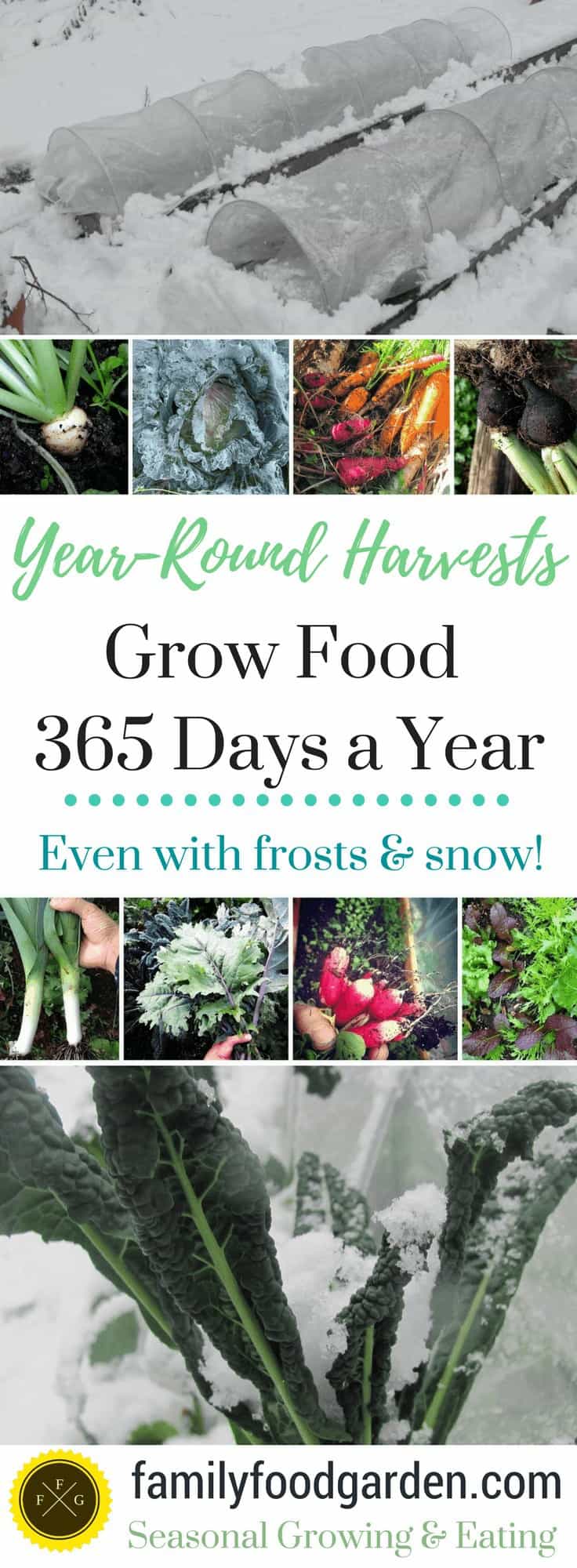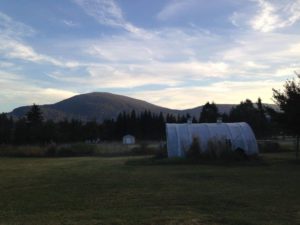
Can you really grow food year-round?
I’ve been trying to grow food year-round in our zone 5 Canadian climate, even with the heavy wet snowfalls and temperatures that dip down to -20C/-4F for years now.
Although growing food year-round might seem like a lot to learn at first, and requires some financial setup costs if you’re using season extenders, it’s really worth the time and money investment if you’re serious about home food production or eating a healthy local diet.
Extending your growing season is one of the best ways to get more from your garden, especially in short season climates. One way to extend your growing seasons is to use an underground greenhouse known as a walipini.

The ability to grow year round does depend on your climate, but as you’ll learn in this article there are many crops you can harvest with unheated season extenders.

Planting the right crops can add weeks to your growing season.
I’ll discuss what these vegetables are that can handle frosts and snow. I also go into overwintering veggies and growing indoors if season extending isn’t possible for you.
The best time to season extend is in the spring and fall, and if you’re feeling extra adventurous, the winter months even with the snow.
How to Grow Year-round
Edited: Since writing this post I’ve written a book on growing greens year-round as they are a super easy crop to focus on when learning how to grow year-round. Also when growing year-round it really helps to stay super organized, which is why I created the ultimate garden planner.
 Selecting the Right Varieties of Crops to Grow Year-round
Selecting the Right Varieties of Crops to Grow Year-round
The days get hotter and longer in the spring so you’ll want to choose cool season crops that are bolt-resistant in the spring. In the fall and winter you’re selecting varieties that are cold hardy as the days get colder with shortened daylight.
Lettuce for example is not very cold hardy but if you grow varieties like ‘Rouge D’hiver’ or ‘Winter Density’ you can harvest in the colder months under tunnels. The same thing goes for springtime, choosing bolt-resistant varieties will help with the increasing heat.
Cool Season versus Cold Hardy
Cool season vegetables thrive in cool temperatures but are less likely to withstand light or hard frosts. Cold hardy vegetables can handle light or hard freezes, and may even overwinter under the snow for a spring harvest. Now this does depend on your climate & growing zone.
List of Cool Season Vegetables
Arugula, beet, broccoli, cauliflower, cabbage, celeriac, chinese cabbage, carrots, swiss chard, chicory (endive, frisee and radicchio), collards, fava bean, Florence fennel, garlic, shallots, kale, leek, lettuce, Asian/mustard greens, spinach, mache, mesclun greens, green onions, bok/pak choi, parsnip, pea, potato, radish, rutabaga, salsify, tatsoi.
Here are some Cold Hardy Crops
- Arugula
- Beets
- Broccoli
- Brussels sprouts
- Cabbage
- Carrots
- Collards
- Kale
- Kohlrabi
- Leeks
- Lettuce
- Mustard
- Rutabagas
- Spinach
- Turnips
- Mache
The cool season and cold hardy vegetables both benefit from added mulch, mini hoop tunnels, cold frames, greenhouses or heavyweight row covers.
Root veggies often taste sweeter after heavy frosts!
We’ve grown carrots, parsnips, turnips and beets for a fall harvest and have left them without protection (although mulching would extend the harvest). We’ve even harvested potatoes that were deep in the ground all winter and harvested in the early spring before they sprouted. Here’s my guide to growing root vegetables year-round.
Crops to Grow with Season Extenders
Believe it or not, there are many cold-hardy crops that can handle frosts, harder freezes, and snow. Some even without the protection of season extenders However, if you want to grow food when the temperatures get really low then you’ll benefit from using season extenders so long as you select the right crops.
Building & Using Season Extenders
Using season extenders might take a little practice but I promise you they’re worth the time to learn (plus the start up cost).
Here’s some info on building & using season extenders:
- Using Hoop Houses and Low Tunnels in the Garden
- Unheated Winter Greenhouse Growing
- Polytunnel Greenhouse
- Using Frost Cloth (Row Cover) in the Garden
- How to Build a Low Tunnel
- Clever Cloches
- Garden with Cold Frames to Grow More Food
- Cold Frame Gardening
- How to Start Seedlings in a Cold Frame

Venting Season Extenders
One of the most important things to remember is to vent your season extenders, the very thing that allows you to keep your crops warmer on the colder days can also get too hot. Venting is key to allowing good airflow and making sure your plants aren’t stressed from the heat; many cool season plants can’t handle and may even try to go to seed (bolt). The image below from Fix.com gives you a good idea of venting, although I strongly disagree with the row cover not needing venting; they definitely do and should be closed at both ends when it gets cold/below 0. In general temperatures above 3C/37.4F needs venting, especially with sunshine. I often don’t put season extenders on until it dips below 0 in the fall to make the plants stronger for the winter.

Tips for Season Extending
- Practice getting the right sowing times and varieties. Every local climate will be different and need slight adjustments. I use this table from West Coast Seeds as a guideline for sowing and transplanting times.
- Use transplants to get a head start in the spring and fall. Your crops will especially come sooner in the spring with transplants under tunnels!
- Succession sowing every week over multiple weeks will help you get the right timing for your crops. You may get heat waves in the spring and fall which cause your plants to bolt. Sowing multiple times helps you still get crops that don’t go to seed.
- Restore the soil! Season extending means you’re growing more crops in a single growing season. It’s important to make sure you restore the soil in-between sowings otherwise your crops won’t have enough nutrients to grow. This is especially important in the fall because they need to grow fast before the cool weather sets in and because of Persephone days.

Planning your Fall/Winter Garden
Garden planning and timing is just as important as which varieties you plan to grow in your fall garden.
Here are some great posts on how to plan and plant your fall or winter garden:
- How to Plant Your Fall Garden
- Cold Hardy Crops for the Fall and Winter Vegetable Garden
- Ultimate Guide to Fall & Winter Gardening
- Fall and Winter Garden Plans and Planting Schedule
- Growing Root Vegetables Year-Round
- Unheated Winter Greenhouse Growing
- 30 Crops to Plant in Summer for a Fall Harvest
- Cheating Winter: The Little-Known Truth about Frost and Freeze Tables
- Calculating Your Garden’s Persephone Days
Can you Really Grow Food Year–round, 365 days a year?
YES. Even with a zone 2 climate, you can grow indoors if you’re not up to/it’s too cold to garden outdoors!!
Indoor Gardening
- Grow Healthy Indoor Microgreens
- How to Grow Lettuce Indoors
- How to Have Baby Greens Year-Round
- Indoor Gardening Infographics
- Growing Popcorn Microgreens
- How to Grow an Indoor Garden
- Best Sprout Makers for Growing Sprouts
- Grow Herbs at Home with a Windowsill Garden
Get spring greens early by foraging, perennials and overwintering
- Spring Wild Edibles
- Best Vegetables to Overwinter in Zone 5
- Perennial Vegetables to Grow
- More early Foraging on Pinterest
Source: Fix.com Blog
Conclusion
Growing food year-round with season extenders can give you weeks more growing time in your garden. I’ve been doing it for years now, experimenting with different varieties and season extenders in our colder northern climate and I can tell you it’s amazing to harvest green food when there’s snow on the ground!
Do you try and grow food year-round?














I would like to use this article in my monthly newsletter for an assisted living community. I also want to promote your book. I’m the activities director and I’m quitting to start a home stead. Many of the residents have asked me exactly what I’m planning to do on the homestead and I think your blog about what to do all year perfectly covers it. I don’t want to infringe on copyright laws because I honestly don’t understand them completely. I read somewhere that I had to have permission. May I please have your permission! I’ll include your name and book.
Hi Russel,
Feel free to share the link of the article but please don’t copy the text or photos. Thank you & best of luck with your homesteading. 🙂
Excellent tips with regards to ventilation. I think I overlooked the importance of this in a previous hoop tunnel project as it wasn’t hugely successful. Planning on having another (better) bash at it later this year. Thank you very much for the article – some very useful Winter tips here!
Best of luck Peter with future season extending. It definitely takes some practice, plus learning the timing and varieties for your microclimate. 🙂
I have tried Winter gardening with some success for the past two years. We are in zone 8a. Everything does great over the winter and starts growing once the weather warms up in early spring. That said every year around first week of March all my brassica family with the exception of colored greens freaks out and start bolting.
I tried small seedlings, so that they can start growing when the weather warms up and I tried half mature plants, so that they can continue growing until end of April or so. Both bolted. My cabbage had may be a week to get hard (head) and BAM one day was gone bolting. I read that you recommend to use “non bolting”varieties. Is this all to it? I bought my previous plants ready to go from the nurseries, thinking they will know what will survive.
Should I start them early enough that they are fully mature to eat over winter and collect all left behind before March?
Happy gardening,
Huli
Hi Huli,
It makes me so happy that you’re winter gardening. In zone 8 your crops will definitely bolt by the spring regardless of age, one might just give you an extra week or two. Our fall & winter sown ones (zone 5) ALWAYS do within a couple of weeks of producing early spring greens (which is happening right now, so the bolting is usually April). That is the downside of fall and winter crops, by the spring they are at the end of their lifecycle so just amend the bed and sow/transplant spring crops.
It’s tricky because the bolt resistant varieties tend to be less cold hardy and crops will bolt if they experienced cold/winter as they’re suppose to go to seed in their second year. I recommend sowing bolt resistant varieties in the spring because of the warming days, your seed catalogs/seed packets will mention which ones have better bolt-resistance, however for fall & winter gardening you want the cold hardy ones (although in zone 8 it might not be that cold during the winter?).
If you transplant seedlings too early in the spring or if you get a cold snap after transplanting sometimes the crops ‘think they went through a winter’ and will bolt too. Bolt resistance helps, but isn’t a guarantee, but they can usually handle more stress than other varieties.
One trick with consistent bolting is also succession planting- so sowing every 1-2 weeks instead of 1-2 months as younger crops will be less likely to try and flower than older plants during those heat waves/stressful periods. Sometimes plants that are from nurseries have already been stressed and will bolt, especially if they weren’t hardened off. I wrote more about succession sowing here: //www.familyfoodgarden.com/succession-sowing-for-optimal-harvests/
I hope this answer helps! Just know that bolting crops is a struggle for many, we get heat waves in the spring and fall and I have to sow smaller rows of crops multiple times because of it. 🙂
I’m planing to make a winter gardening this year and I don’t know what to do or where to start with! Thanks for sharing your useful tips! Now I just need to do it right away!
I love fresh vegetables. So great to know that I can enjoy some even after the first frost. Winter is a great time to use those fresh veggies in some warm soup. Thanks for sharing!
Wow! So much great information. I especially love all of the infographics. It makes everything so easy to understand. Can’t wait to start trying some of these techniques to keep some fresh food in the house all year long.
This is very comprehensive. The list of cool-season veggies is particularly helpful. As an alternative to hoop houses and low tunnels, DIY geodesic domes could also do the trick for trapping heat and protecting plants from frost.
Thanks for sharing these! I have bought a glass greenhouse for my garden and I will start growing my favorite plants soon.